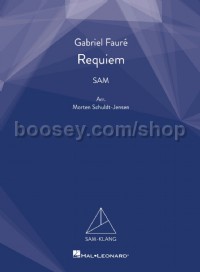Requiem (SAM & Organ)
Requiem (SAM & Organ)
Bulk Discounts Available
* Estimated price converted from UK retail price
Gabriel Fauré’s Requiem is arguably the best-known and most frequently performed choral work from the late 19th and early 20th centuries. As both choirmaster and organist, Fauré sought to fashion a new church music removed from both the bel canto that held sway in Paris and the large-scale German romantic style that dominated much of Europe. His distinctive musical language laid the foundations for the Impressionist school of Debussy and Ravel (his pupil) that followed.
With versions for church (1893) or concert hall (1900), the Requiem is almost unique in its serenity, most notably by dint of the omission of a full Sequence Dies irae and its seraphic final In Paradisum. The work subscribes to Fauré’s belief that death should be seen ‘as a happy deliverance, an aspiration towards happiness above, rather than as a painful experience.’
The piano reduction here remains faithful to the edition by Desmond Ratcliffe published by Novello in 1975. Fauré’s original tempo and subtleties of dynamics have been kept, although some of the composer’s original breath markings, now considered superfluous in contemporary scoring, have been removed. The passages for tenor voices in the Introit and Agnus Dei may be sung by all lower voices if this is practical. If not, the line may be taken by a mixture of higher male voices and altos.
Editorial note: By its nature, this SAM-Klang edition offers the occasional challenge with a somewhat higher level of activity than in the original SATB version, and in some places a slight redistribution of entries in the polyphonic sections was necessary. Despite this, the original orchestral accompaniment can be used together with this version without restraint, and the work can also be easily performed with the piano reduction.




